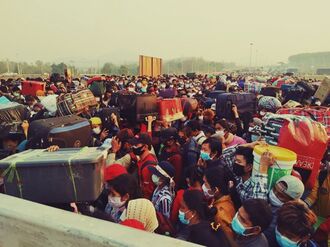1994 Ther migrant crisis
The 1994 Ther migrant crisis was a period of increased migration from Thervala to Ogonkai. An unprecedented 1.1 million people migrated from Thervala during this time, in two waves of around 550,000 people from 1994 to 1996 and 1998 to 2000. The migrants, in their majority, belonged to the lower class, although middle and upper class Ther people also migrated during this time. This crisis occurred concurrently with the 1993 Kandaran crisis in Ogonkai's southern border. This crisis had many causes; chiefly among them were the economic downturn that Thervala had been suffering ever since the collapse of the Thervalan bubble and a general decline in quality of life in Thervala after its economic implosion and, later on in the crisis, increased crime.
 Ther migrants in one of the border checkpoints between Ogonkai and Thervala | |
| Date | 1994-2000 |
|---|---|
| Location | Ogonkai |
| Cause | Economic instability, social downturn, crime and others |
| Outcome |
|
The Government of Ogonkai was already strained resource-wise given that it was managing the Kandara-Ogonkai border to prevent an uncontrolled influx of people. Thus, initial actions proved erratic at first and exacerbated the problem. The discoordination between the prefectural government of Iwanobe (that received the brunt of the population flow) and the federal government of Ogonkai further worsened the situation and queues in the sparse pedestrian checkpoints installed across the lengthy border soon became hotspots for theft, episodes of abuse by both Ogonkan and Ther police officers on both sides of the border and other humanitarian issues. Queues in the border crossing checkpoints initially lasted for months.
After the start of the crisis, the Council of Ogonkai voted in an unprecedented 8-4 decision to establish a state of emergency in the prefecture of Iwanobe. The National Council of Ogonkai, represented by then-representative of Hakusan Saneuji Goto, met with Thervalan king Ananda Varma I and a few months later the two countries agreed to militarize the border, temporarily stopping migration at the cost of heavy international condemnation at Ogonkai's treatment of stranded Ther migrants.
The migrant crisis and the actions taken by the government of Ogonkai have had drastic political consequences in the country. The influx of migrants, while seen in a positive light by the inhabitants of Iwanobe (who have a rich history with the Ther people and their culture) was seen negatively by most Ogonkans, spurring increased xenophobic attitudes that reflected in the 1996 elections where the right-leaning Democratic Progress Party achieved a landslide victory across all prefectures except for Iwanobe, Narazaki and Shimakoshi.
Consequences were most notable in Iwanobe; the declaration of a state of emergency in the prefecture brought with it widespread claims by Iwanobe residents and political figures that the National Council was overstepping its boundaries. The migrant crisis is one of the key reasons of the revival of the previously-stagnant Iwanobe Prospers party, which after the crisis adopted a more hardline regionalist approach. In what is seen as a partial political and social rupture between Iwanobe and the rest of Ogonkai, the prefecture has since then voted for Iwanobe Prospers consistently since 2000, only losing in the 2010 and 2022 elections.